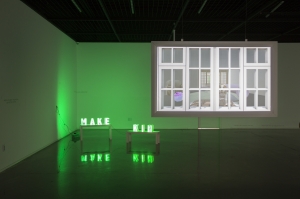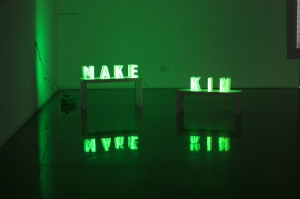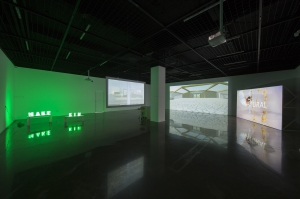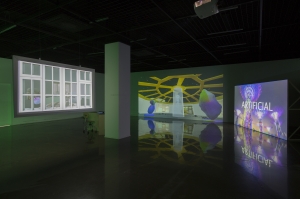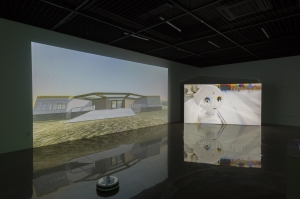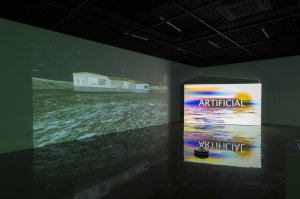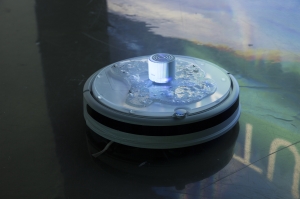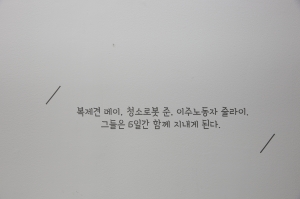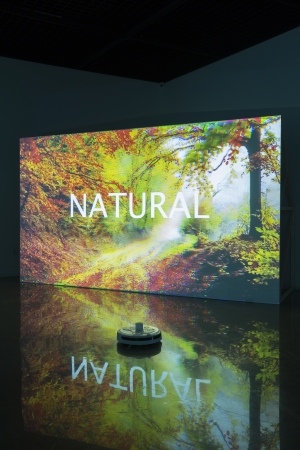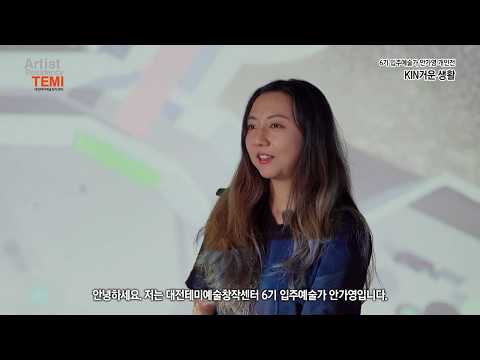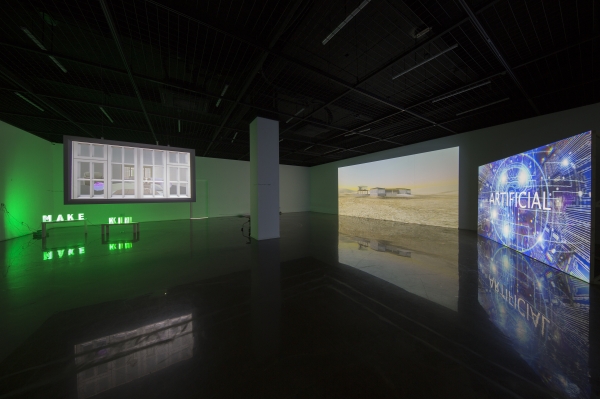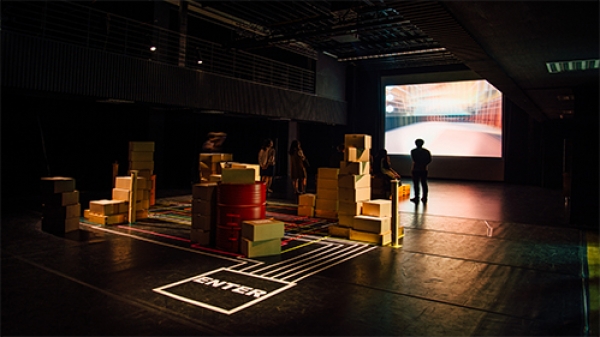전시 EXHIBITION
입주예술가 개인전KIN거운 생활
“복제견 메이, 청소로봇 준, 이주노동자 줄라이. 그들은 6일간 함께 지낸다. 그들의 몸이 머무는 공간은 지금은 사람들의 발걸음이 끊겨 버렸지만 소도시의 산기슭. 옥토망월(玉兎望月)의 명당. 비가 올때 배가 되기도 하고 달이 뜰때 우주선이 되기도 했다. 자신을 대체할 수 있는 존재들이 어디에나 존재하는 존재들. 한때 각 사회 기관의 충실한 일꾼이었지만 나이가 먹거나 성능이 뒤떨어지거나 병에 걸리거나 정당한 임금을 받지 못하여 생활을 유지하지 못하거나 그들의 쉼터가 파괴되어 돌아갈 곳이 없는 존재들. 그 존재들을 환영하지 않는 도시로부터 달아나 당도한 이 곳은 부적당한/마음대로 전용할 수 없는 존재들을 위한 레지던시가 된다.”
< KIN거운 생활 >은 사회문화, 과학기술, 그리고 예술과 삶의 경계에 있는 각기 다른 종들의 반려가능성에 대하여 질문하는 SF월딩 시뮬레이션 게임이다. 나는 게임에 등장하는 NPC(Non Player Character)가 플레이의 주변부에 존재하는 것이 아니라 그들이 플레이어의 많은 개입없이도 놀 수 있는 플레이그라운드, 즉 가상의 생태계를 만들고 싶었다. 그리하여, 게임 ‘심즈(Sims)’를 모티브로 캐릭터들이 자유의지와 성향에 따라 움직이고 일상을 살아가는 < KIN거운 생활 >을 제작하게 되었다. 멀지 않은 미래를 배경으로, 스피너 모양처럼 생긴 건축물의 방 안에는 각기 다른 종들, 복제견, 청소로봇, 감염된 이주노동자들이 살고 있다. 그리고 이주노동자의 반려해파리도 함께 살고 있다. 이들은 입주 첫날 매우 어색한 시간을 보내지만 점차 자신의 임무에 따라 움직이기 시작하고, 다른 이들과 부딪히거나 친밀감을 쌓아간다(또는 사이가 멀어질 수도 있다.). 6일간의 시간동안, 친밀한 자에 대해서는 더 강한 끌림이, 덜 친밀한 자에 대해서는 불편함과 혐오의 감정이 북받쳐 오른다. 감정의 변화에 따라 대상에 대한 인식이 전환되고, 팽팽한 삶의 균형을 이루던 그들의 관계들 또한 변화한다. 그렇게 살아가면서 그들은 함께 KIN(친족)이 되기도 하고 KIN(온라인 게임 상 배척의 언어)이 되기도 한다. 그러나 친족이 된다고 무한히 행복한 미래가 펼쳐지는 것도 아니고, 상대를 혐오하고 차단한다고 해서 무균상태의 안락한 공간을 점유할 수 많은 없다. 임시적이고 일시적인, 필멸의 존재들이 얽히고 설키는 관계적 게임은 레지던시에 또 다른 방문자들이 찾아오면 다른 양상을 연출하며 반복될 것이다.
1. KIN거운 생활.beta
2. 윈도우 너머 ASMR
이 작품에서 윈도우는 건축 구성요소 중 창문을 의미하면서 동시에 컴퓨터의 '창(window)를 의미한다. 리어스크린에 투사된 영상에서 관객들은 캐릭터들이 일상 생활을 영위하는 장면을 볼 수 있다.
'반려를 위한 건축'의 큰 틀을 제작한 후 각 캐릭터의 속성에 맞는 인테리어를 고안했다. 그 중 가장 고민했던 부분은 바로 창문이었다. 우울증을 앓고 있는 메이에게 햇빛은 긍정적인 에너지를 줄 것이지만, 로봇 준에게 햇빛이 필요할까? 또는 병든 인간 줄라이에게 열린 창문을 통해 들어오는 햇빛은 유해물질이 되기 때문에 보호장치가 필요하지 않을까? 이러한 배려를 통하여 놓여진 창문 밖으로 관객들은 이들의 삶을 관찰한다.
3. 밀레니엄 과학의 꿈
전시장이 하나의 가상공간이라면, 전시장을 돌아다니는 로봇청소기는 이 가상 게임의 적극적인 플레이어이다. 그는 전시장 곳곳을 탐색하며 가끔씩 한마디 외친다. "새천년, 새시대, 새희망 과학기술". 이 문구는 대전 국립중앙과학관에서 마주친 1999년에 쓰여진 과학자들의 글들에서 발췌하였다.
4. 친족을 만들어라!
친족을 만들어라! Make KIN는 학자 도나 해러웨이의 "Making kin, not babies"의 문구에서 가져왔다. 해러웨이는
-
‘지구생존을 위한 스토리텔링’은 게임의 전유를 통해 어떻게 확장 가능한가?
이진실 미술평론
‘나는 여신보다 차라리 사이보그가 되겠다’는 급진적인 선언으로 유명한 사회생물학자이자 페미니스트인 도나 해러웨이는 2003년 <반려종 선언(The Companion Species Manifesto: Dogs, People, and Significant Otherness)>이란 글을 내놓았다. 18년만에 내놓은 이 선언문은 과거 급진적 상상력과 치밀한 생명과학적 논의 대신, 치매에 걸린 늙은 개 카옌과 나바호 바구니, 그리고 이웃하는 인간 친구들과 대안적 ‘가족’을 이루고 살아가고 있는 그녀 자신의 삶에 더 밀접한 선언이었다. 1985년 <사이보그 선언>이 기존 페미니즘이 지닌 기술배타적 경향과 생물학적 결정론의 한계에 도전하며 페미니즘 이론사에서 급진적 사변의 한 획을 그었다면, 뒤를 이은 <반려종 선언>은 갈수록 정치적 반목과 분열을 거듭하고 있는 전지구적 현실에서, 또 ‘인류세’라는 명칭으로 떠오른 위기 의식 속에서 공생에 대한 더 현실적이고 실천적인 통찰을?더 능란해진 그녀의 유머와 함께?보여주고 있다. 최근 한국에서는 페미니즘 열풍으로 해러웨이의 사상이 재조명되고 있는데, 이는 TERF(trans-exclusionary radical feminist, 트랜스배제 급진 페미니즘)로 대표되는 생물학적 본질주의 및 분리주의로서의 페미니즘을 극복할 이론적 기반으로서 호출되는 동시에, 기후 위기가 선언된 동시대가 그녀의 선구적이고 복합적인 전망을 절실히 필요로 하고 있기 때문인 듯하다.
3D 게임그래픽으로 구현한 쉼터는 미래적이지만 그다지 유토피아적이지 않고, 고립무원처럼 보이지만 옥토끼가 보름달을 바라본다(옥토망월)는 풍수지리적 명당이라고 설정되며, 지구상에 존재할 것도 같지만 우리가 사는 아파트들의 군도와는 전혀 다른 낯설고도 소외된 공간이다. 장기적 거주지라 할 수 있는 그 공간이 현실이라면 우리는 기꺼이 그 곳에 거주할지 망설이겠지만, 관객으로서 게임 속 캐릭터들이 ‘거주’한다는 그 공간에 접속하는 행위에는 어떤 책임감도 망설임도 없을 것이다. 그 망설임 없는 시작을 필요로하는 함정같은 가벼움이 안가영 작가가 사이보그처럼 웃으며 안내하는 새로운 세계의 입구다.
이번 개인전
이렇게 배타적인 취급을 받을 수밖에 없는 현 시대 존재들의 공생 가능성이 ‘KIN거운 생활’의 테마이다. 작가는 게임의 공간에 하나의 쉘터를 만들고, ‘석탄기’라고 불리는 급속한 사회발전 속에서 도구로 사용되고 폐기된 유기체적/비유기체적 존재들을 거주시켰다. 그곳은 버려진 자들의 일상적 주거지이면서, 노아의 방주처럼 운명적인 폐기/죽음에서 그들을 구해내는 마지막 피난처다. ‘건강’하고 ‘합리적’인 사회에서 버림 받은 세 캐릭터들은 각자의 이야기를 지니고 있다. 복제견 메이는 공항에서 마약탐지견으로 일하다가 실험대상이 되었고, 청소로봇 준은 인공지능기술이 발전함에 따라 낙후한 산업폐기물로 전락했으며, 이주노동자 줄라이는 공장의 방사선에 피폭되어 병들었다. 이들은 오픈베타 버전의 게임
냉정하게 말하자면, 이 베타 버전의 게임이 앞으로 얼마나 업데이트될 수 있을지 모르지만, 게임이라는 장르가 지닌 소구점과 미술 전시의 조건이 상충하는 한, 작가가 시도하는 스토리텔링의 구현은 맹점을 지닐 수밖에 없는 것으로 보인다. 캐릭터의 폭과 성격 규정, 그리고 상황 설정 범위가 무척 제한적인 상황에서 관객은 이 게임을 관람의 대상으로 삼아야 하는가, 일시적 플레이로 참여해 어떤 공존의 양태를 적극 만들어가야 하는가? 작가가 목표하는 지점은 전자인가 후자인가? 게임이라는 형식의 매력은 현실에서 실현해보지 못하는 행위, 감각을 현실감있게 체험하는 것이고 그 쾌감과 중독성이 지속적인 참여를 좌우하는데, 지속적이고 몰입감있는 사적 플레이, 혹은 그 쾌감을 공유하는 가상의 커뮤니티가 불가능한 공간인 전시장에서 ‘즐거운 생활’은 어떻게 탐험 가능할 것인가. 미술 전시장으로 들어온 게임, 즉 적극적인 감정이입, 상황의 조작, 시나리오의 확장 여부가 (적어도 전시장에서의 경험으로는) 불투명한 규모의 작업에서 어느 정도의 인터랙티브 요소를 추가한들, 이는 결국 관찰의 대상이자 현실을 반추하는 스크린으로 전락할 수밖에 없는 것 아닌가. 단지 이론적 지지, 논리적 설득력을 관객이 수용하는 것이 아니라, 작품이 관객의 수행성을 통해 온전히 구현되기 원한다면 작가가 풀어야 하는 질문들일 것이다.
오히려 우리가 습관처럼 인식하고 살아가는 인공/자연의 이분법과 타자성의 경계는 각기 다른 조형적 장르를 선보이는 전시의 구성물들에서 도전받는다.
최근 들어 등장한 ‘포스트-인터넷 아트’라는 화두를 입고, 첨단 디지털 기술, 편재하는 인터넷 네트워크 환경과 지각체험은 동시대미술에서 중요한 테마로 부상하고 있다. 여기에는 과거 ‘미디어 아트’ 혹은 ‘뉴미디어 아트’라는 이름으로 유행했던 성급한 기술적 매개보다는 디지털 네트워크의 가상성이 현실에 미치는 여파를?혹은 그 상호적 순환을? 탐색하는 현상학적 접근이 더 주효하게 논의되고 있다. 게임을 작업의 테마로 삼거나, 게임의 경험을 세대적 문법으로 삼는 작업들도 그러한 맥락에서 주목받곤 한다. 그럼에도 불구하고, 전통적인 미술의 조형성과 현장성의 바깥을 탐색하는 매체 실험은 여전히 유효한 가능성의 영역이다. 게임의 언어를 작업의 본진으로 삼기보다 이를 전유하고 융합해가는 미술 프로젝트는 어떻게 확장 가능할까. 그리고 거기에서는 어떤 발화가 가능할까. 이런 질문들이 여전히 남아있는 것이다.
어떻게 보면 안가영 작가는 이런 실험을 가장 적극적으로 하고 있다고 말할 수 있을 것이다. 미술에서 게임의 형식이나 언어가 전유의 대상이 되는 차원은 일차적으로 게임 속 가상현실이 현실의 지각양식을 지배하게 되는 상황을 문제시하거나, 그러한 지각적 전이에 깃든 이데올로기적, 병참학적, 테크노크라시적 양상을 지적하는 데 있었다. 아니면, 기술자본주의의 병참학, 신자유주의적 메트로폴리스의 문제적 상황이나 세대적 자기 환시에 대한 노출에 가까운 작업들이 있을 것이다. 때문에 저 멀리 파룬 하로키로부터 가까이로는 김희천이나 안성석의 작업에 이르기까지, 관람의 대상으로서 게임의 인터페이스를 차용한 작업은 지각의 메타역사적 진술이며, 그 매체는 대개 스크리닝 영상을 바탕으로 한 설치라는 재현적 차원으로 귀결되곤 한다.
한편, 안가영은 게임의 인터랙션을 이용한 미디어 아트라는 성격을 더 분명히 하는 반면, 작업이 던지는 질문의 지점은 게임이라는 디지털 환경 속에서 여성이 겪는 경험과 페미니즘적 대안의 모색에 있다. 게임을 전유하는 방식 또한 디지털 스크린이나 단순한 게임의 인터랙션 요소를 들여오기보다 게임적 세계관, 혹은 스토리텔링의 차원을 전격 각색하는 데 주안점을 둔다. 두 번째 개인전 <헤르메스의 상자>(2016)에서 MMORPG 게임의 형식으로 구현한 세계는 정보의 전달과 바이러스라는 양가적 속성을 통해 인터넷 공간의 윤리와 영향관계를 좇는 아이러니한 프로세스를 구현했으며, <월딩Wordling>(2018)이란 작업에서도 불확실성의 세계에서 공존을 모색하는 ‘세계짓기’라는 테마를 환상적인 시뮬레이션 게임으로 개발했었다. 이러한 시도는 매번 새로운 작품의 면모를 입증해야하는 단속적인 미술계의 사이클과 불화하는 작업방식이라는 점에서, 또 게임 개발이 통상 한 사람의 역량보다는 어느 정도 규모를 지닌 팀워크로 구현되는 프로세스라는 점에서 매번 쉽지 않은 난관을 약속한다. 때문에 나는 작가와 대화를 나누는 자리에서 게임 개발에 매달릴 것인가, 전시로 보여주는 형식에 집중할 것인가 어느 정도는 양자택일을 해야 할 것이라고 주제넘은 조언을 했는데, 그것이 잘한 일인지는 확신이 서지 않는다. 미술 작가로서 수행하게 될 속도와 규모, 궤도라는 조건을 따져야 한다는 지극히 계산적인 나의 제안이 그녀에게 별로 통할 것 같지도 않고, (특히 여성작가로서) 이런 드문 시도가 낳을 누구도 모를 확장가능성을 주저앉히는 일은 아닌가 싶은 것이다.
How Could “Storytelling for the Survival of the Earth” be Extended to the Appropriation of Online Gaming?
Jinshil Lee(Art Critic)
Donna J. Haraway, a sociobiologist and a feminist famous for her radical remark, “I would rather be a cyborg than a goddess,” published The Companion Species Manifesto: Dogs, People, and Significant Otherness in 2003. This manifesto that Haraway wrote over 18 years was not about her radical imagination from the past, nor an elaborate sociobiological discussion. Rather, it was something closer to her own life ? the formation of an alternative “family” that included an old dog, Cayenne, that was suffering from dementia, a Navajo weaving, and her neighboring human friends. Her 1985 A Cyborg Manifesto and its radical remarks marked a new era in the history of feminist theory, challenging the technological exclusiveness of existing feminism and the limitations of biological determinism. On the other hand, the following publication, The Companion Species Manifesto: Dogs, People, and Significant Otherness, depicts more realistic and practical insights ? along with her dexterous humor ? about the global reality of political opposition and division, and coexistence in the midst of the feeling of danger called the “Anthropocene.” The growing feminism fever in Korea is shedding new light on Haraway’s idea. It seems to be the theoretical foundation that could overcome biological essentialism and separatism, represented by what is called TERF (Trans-Exclusionary Radical Feminism) and the climate crisis of this era that needs her pioneering and comprehensive prospect.
The solo exhibition of Gayoung An, In the Shelter, is based on the key discussion of Haraway’s The Companion Species Manifesto: Dogs, People, and Significant Otherness and Staying with the Trouble. The word “KIN” that was used in the Korean title refers to relatives in English. She borrowed it from Haraway’s slogan “Make kin, not babies!” that suggests that we should become relatives to various kinds living things ? such as non-human ? instead of being obsessed with human bloodlines and reproduction. The word “KIN” also holds a double meaning when used online as it can refer to an abbreviation of the phrase “Have a great time” in Korean, but it also could mean “Beat it” when used by online gamers. By using a word that could mean relatives in one language and also means a word of rejection and banishment in another community, the artist invites the audience into a “shelter” where disharmony and inconvenience coexist.
The shelter made of 3D computer graphics is futuristic, but not a utopia. It seems to be isolated, but it is considered to be in an ideal spot according to the theories of geomancy. Perhaps it looks like a place that may exist on earth, but it is a completely unfamiliar, an alienated space apart from the apartment archipelago. If that place were real, offering a long-term stay, then we would be reluctant to live there. However, we would not be hesitant, nor feel responsible, in accessing the space to have our game characters live there. Gayoung An smiles like a cyborg and leads you to the entrance to this new world, which invites you to enter without hesitation ? and all of this is a trap.
The beginning of this solo exhibition, In the Shelter, was her work created in 2018, Companion Species Permission Test. With the project named Companion Art Declaration, she conducted a survey that asked what was the range of pet species that people could live with. People easily gave an answer about mosquitos, fruit flies, and cockroaches ? that they need to “be isolated and eliminated”, “be abhorred”, or “able to coexist”. However, there were ethical conflicts about whether we should live together with people exposed to radiation, anti-feminists, and Muslim refugees. While the treatment of beings that are pests or those that invoke pity can be easily determined, a decision to coexist with those of similar hierarchies as us, with uncertain risk, or humans with different values, or those who cause great distress, made people contemplate the issue more. This gives us a hint as to the desire for existence reflected in the people of this era.
The possibility of coexistence in those living in this era ? being treated with unfriendly attitudes ? is the theme of this exhibition. The artist creates a shelter in the game space for organic and inorganic beings that were once used as tools, but have now been discarded in the rapidly developing society of the Carboniferous period. The place is a home to those who were abandoned and it is the last shelter, like Noah’s ark, that saves them from death. Each of the three characters who were abandoned from a “healthy” and “rational” society has a story of their own. A cloned dog, May, has worked as a drug detection dog at the airport, but then became a subject in animal testing. The cleaning robot, June, has become industrial waste as new AI technology developed. The immigrant worker, July, became sick after being exposed to radiation from a factory. They are NPCs (non-player characters) in the open beta version of the game. The players can control the characters to a certain degree, but they form relationships after following the characters’ autonomous movements, and such relationships become a variable to unfold further activities. NPCs are usually extras or uncontrollable characters in games, such as enemies, not player avatars. The artist explains that it is similar to the game called "The Sims" in the sense that the determinism of May, June, and July depends not on the player, but on the game's story setting and the variables of the environment. However, unless there are various variables that can be controlled, like in The Sims, the contingency elements outside of the user’s control are nothing but an initial story and situation setting. Moreover, it is difficult to realize the process of how these NPCs can coexist in the exhibition space unless one continuously interacts with the game online.
Bluntly speaking, I am not sure how much this beta version of the game will be updated in the future, but as long as there is a conflict between the prerequisites of the genre of the game and the conditions of the art exhibition, the implementation of the storytelling attempted by the artist will always have loopholes. In a situation where the character interactions, personality rules, and setting ranges are very limited, should the audience be the target of the game, or should they participate and play at actively in creating a mode of coexistence? What is the goal of the artist ? the former or the latter? What makes games attractive is the realistic experience of the behavior and sensations that cannot be grasped in reality, and it is that pleasure and addictiveness that encourages players to continue participating. If so, how can the fun of it be explored in an exhibition hall, where it is impossible to continue a private, immersive gameplay or to create a virtual community that shares such pleasures? It is a game brought into an art exhibition hall. In other words, no matter how many interactive elements are added, it will only be a screen that is an object of observation and reflection on reality as long as there are limitations regarding any active empathy, the manipulation of its situations, and the expansion of its scenarios (at least through the experience presented at the exhibition). If the artist wishes the audience to accept her theoretical support and logical persuasiveness, while also realizing the artwork through the performance of the audience, then there are many more questions that the artist needs to come up with a response to.
The dichotomy between the artificial, the natural, and the otherness that we perceive as habits are challenged in the compositions of the exhibitions that show different formative genres. In the Shelter displays game simulation devices along with various symbols that the artist wishes to suggest. There are various cheat keys in different parts of the exhibition that show the moot points that the artist wishes to convey through the world, even without the audience playing the game. The starting point of the exhibition features lighting that says, “MAKE KIN”. In one corner, a video titled “Nature” plays like a billboard in a public place, giving off a fantastic and complete image of nature that we often see as computer screensavers. Nature is the landscape of a vital organic ecosystem, but it is an artificial illusion and an original simulacre that we have already idealized more than its actual reality. On the floor, the cleaning robot, June, moves around with a speaker as if it has jumped out from the game. The speaker plays 1999 technological utopian phrases of the new millennium.
The topic of “post-Internet art,” which has emerged in recent years, consisting of advanced digital technology, a ubiquitous Internet network environment, and perceptual experience, is becoming an important theme in contemporary art. The phenomenological approach to exploring the aftermath of the digital network's virtual reality ? or its mutual circulation - is discussed more effectively, rather than the hasty technological mediums that were popular in the past, under the name of “media art” or “new media art”. Art that uses gaming as the theme, or makes the game experience a generational grammar, often get attention in that context. Nevertheless, the media experimentation that explores the formativeness of traditional art, and the realities of the field, is still an area of valid possibility. How can the art project expand and approve, rather than make the language of the game the main source of the work? And what can come out of it? Such questions still remain unanswered.
In a sense, it can be said that Gayoung An is doing the experiment most actively. The dimension in which the form or language of the game is the exclusive object of art is primarily concerned with criticizing the situation where virtual reality in the game dominates the perceived style of reality, or the ideological, logistical, and technocratic aspects of such a perceptual transition. If it weren’t, there might be art that is close to the logistics of technological capitalism, the problematic situation of neoliberal metropolises, or the exposure to generational self-illusion. Therefore, the work that borrowed the interface of the game as the object of viewing, from Harun Farocki to the work of Heecheon Kim and Sungseok Ahn, is a meta-historical statement of perception, and the medium often results in a reproducible dimension of installation based on screened images.
On the other hand, Gayoung An makes media art using game interactions clearer, while the point of the work is to find female experiences and feminist alternatives in the digital environment of games. As the way to explore a game, An focuses on dramatizing the game world or storytelling, rather than adopt digital screens or simple game interactions. In her second solo exhibition, The Hermes’ Box in 2016, a fully realized MMORPG world emerged with the ironic process of following ethics in the online space and influencing relationships using the ambivalent attributes of the Internet ? delivering both information and viruses. In Wordling (2018), An developed a fantastic simulation game with world-building as the theme, which seeks to find coexistence in a world of uncertainty. Such an approach is destined to encounter challenges as the artist’s work is in discord with the intermittent cycle of the art world, where the artist is required to show a new facet of her work every time, and also because the development of a game usually demands a team effort. For this reason, I offered presumptuous advice while having a dialogue with the artist ? which I am still uncertain if I should have done, where I told her that she would have to select between the development of the game or the form of the exhibition. It seems that she hardly cared about my extremely computational suggestion about having to calculate the speed, scale, and trajectory of performing, and I am concerned that my suggestion could stop the potential to expand such rare attempts (especially by a female artist) that she brings forth.
- 기간
- 2019-08-08 ~ 2019-08-18
- 관련행사






